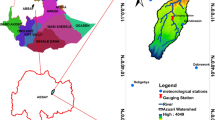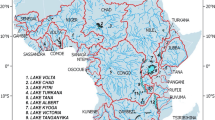Abstract
Inland lakes are important water resources in arid and semiarid regions. Understanding climate effects on these lakes is critical to accurately evaluate the dynamic changes of water resources. This study focused on the changes in Sayram Lake of Xinjiang, China, and addressed the effects of climate fluctuations on the inland lake based on long-term sequenced remote sensing images and meteorological data from the past 40 years. A geographic information system (GIS) method was used to obtain the hypsometry of the basin area of Sayram Lake, and estimation methods for evaporation from rising temperature and water levels from increasing precipitation were proposed. Results showed that: (1) Areal values of Sayram Lake have increased over the past 40 years. (2) Both temperature and precipitation have increased with average increases of more than 1.8°C and 82 mm, respectively. Variation of the water levels in the lake was consistent with local climate changes, and the areal values show linear relationships with local temperature and precipitation data. (3) According to the hypsometry data of the basin area, the estimated lake water levels increased by 2.8 m, and the water volume increased by 12.9×108 m3 over the past 40 years. The increasing area of Sayram Lake correlated with local and regional climatic changes because it is hardly affected by human activities.
Similar content being viewed by others
References
Angel J R, Kunkel K E. 2010. The response of Great Lakes water levels to future climate scenarios with an emphasis on Lake Michigan-Huron. Journal of Great Lakes Research, 36: 51–58.
Bai J, Cheng X, Li J L, et al. 2011. Changes of inland lake area in arid Central Asia during 1975–2007: a remote-sensing analysis. Journal of Lake Sciences, 23(1): 80–88.
Bates B C, Kundzewicz Z W, Wu S, et al. 2008. Climate change and water. Technical Paper of the Intergovernmental Panel on Climate Change, IPCC Secretariat, Geneva, 210.
CGIAR-CSI. 2008. SRTM 90 m Digital Elevation Data. International Centre for Tropical Agriculture (CIAT). [2008-08-19]. http://srtm.csi.cgiar.org.
Ding Y J, Liu S Y, Ye B S, et al. 2006. Climatic implications on variations of lakes in the cold and arid regions of China during the recent 50 years. Journal of Glaciology and Geocryology, 28(5): 623–632.
Du Y Y, Zhou C H. 1998. Automatically extracting remote sensing information for water bodies. Journal of Remote Sensing, 2(4): 264–269.
Earth Resources Observation and Science Center (EROS). 2013. USGS Global Visualization Viewer. Virginia: U.S. Geological Survey. [2013-01-15]. http://glovis.usgs.gov.
Fan Z L, Li J. 1984. Recent changes in the lakes of Xinjiang. Geographical Research, 3(1): 77–86.
Gao H Z, Jia Y L. 2005. The evolution characteristics of typical inland lakes in northwest china during the past 40 years and their mechanism. Journal of Arid Land Resources and Environment, 19(5): 93–96.
Guo N, Zhang J, Liang Y. 2003. Climate change indicated by the recent change of inland lakes in northwest China. Journal of Glaciology and Geocryology, 25(2): 211–214.
Hu R J, Ma H, Fan Z L, et al. 2002. The climate trend demonstrated by changes of the lakes in Xinjiang since recent years. Journal of Arid Land Resources and Environment, 16(1): 20–27.
Li J L, Fang H, Bao A M, et al. 2011. Spatio-temporal analysis of recent changes of lake area and lake water level at high mountains in Central Asia. Resources Science, 33(10): 1839–1846.
Liu H, Jezekk C. 2004. Automated extraction of coastline from satellite imagery by integrating canny edge detection and locally adaptive thresholding methods. International Journal of Remote Sensing, 25(5): 937–958.
Luo J C, Sheng Y W, Shen Z F, et al. 2009. Automatic and high-precise extraction for water information from multispectral images with the step-by-step iterative transformation mechanism. Journal of Remote Sensing, 13(4): 604–615.
Ma D D, Zhang L P, Wang Q J, et al. 2003. Influence of the warm-wet climate on Sailimu Lake. Journal of Glaciology and Geocryology, 25(2): 219–223.
McFeeters S K. 1996. The use of normalized difference water index (NDWI) in the delineation of open water features. International Journal of Remote Sensing, l7(7): 1425–1432.
Ouma Y O, Tateishi R. 2006. A water index for rapid mapping of shoreline changes of five East African Rift Valley lakes: an empirical analysis using landsat TM and ETM+ data. International Journal of Remote Sensing, 27(15): 3153–3181.
Qin B Q. 1993. The response of interior lakes to climate change in Central Asia. Journal of Lake Sciences, 5(2):118–127.
Shi Y F, Zhang X S. 1995. The effect of climate change on surface water resources and future trend in the northwest arid region, China. Science in China: Series B, 25(9): 968–977.
Tang Q C, Qu Y G. 1992. Hydrology and Water Resources Utilization in Arid China. Beijing: Science Press.
Tao F L, Yokozawa M, Hayashi Y, et al. 2005. A perspective on water resources in China: interactions between climate change and soil degradation. Climatic Change, 68(1–2): 169–197.
Wang R, Ernst G, Gao Q Z. 2003. The recent change of water level in the Bosten Lake and analysis of its causes. Journal of Glaciology and Geocryology, 25(1): 60–64.
Xaymurat A. 2010. Analysis of characteristics and long-term trend of water surface evaporation of west Tianshan Area in last 50 years. Hydrology, 30(6): 88–92.
Xinjiang Institute of Geography, the Chinese Academy of Sciences. 1986. Tianshan Mountains Evolution. Beijing: Science Press. Xinjiang Integrated Scientific Investigation Team of the Chinese Academy of Sciences. 1966. Xinjiang Hydrogeography. Beijing: Science Press.
Yang F X. 2011. Xinjiang Geomorphology and Environmental Effect. Beijing: Geology Press.
Yang H B, Wang Z M, Zhao H L, et al. 2011. Water body extraction methods study based on RS and GIS. Procedia Environmental Sciences, 10: 2619–2624.
Zhou C H, Luo J C, Yang C J, et al. 2000. Flood monitoring using multi-temporal AVHRR and Radarsat imagery. Photogrammetric Engineering & Remote Sensing, 66(5): 633–638.
Zhou C H, Luo J C, Yang X M, et al. 2003. Geo-understanding and Analysis in Remote Sensing Image. Beijing: Science Press.
Zhu D G, Meng X G, Zheng D X, et al. 2007. Change of rivers and lakes on the Qinghai-Tibet Plateau in the past 25 years and their influence factors. Geological Bulletin of China, 26(1): 22–30.
Author information
Authors and Affiliations
Corresponding author
Rights and permissions
About this article
Cite this article
Chai, H., Cheng, W., Zhou, C. et al. Climate effects on an inland alpine lake in Xinjiang, China over the past 40 years. J. Arid Land 5, 188–198 (2013). https://doi.org/10.1007/s40333-013-0156-0
Received:
Revised:
Accepted:
Published:
Issue Date:
DOI: https://doi.org/10.1007/s40333-013-0156-0




